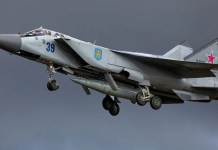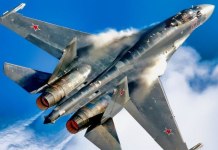China is increasingly getting closer to becoming a global power in the race with Russia and the US by upgrading its strategic bombers to carry nuclear payloads and intending to deploy nuclear weapons in air, land, and sea.
Who Are India’s “Special Frontier Force” That Thwarted Chinese Actions At Pangong Tso?
Pentagon’s annual report to the Congress titled ‘Military and Security Developments Involving the People’s Republic of China 2020’ warned about China’s growing nuclear force which is likely to double its nuclear warhead stockpile in the next decade.
“Over the next decade, China will expand and diversify its nuclear forces, likely at least doubling its nuclear warhead stockpile,” according to the 200-page report. “China’s nuclear forces appear to be on a trajectory to exceed the size of a ‘minimum deterrent’ as described in the PLA’s own writings,” it added, referring to the People’s Liberation Army.
The report also revealed that China launched more ballistic missiles for testing and training than the rest of the world combined in 2019.
However, analysts have questioned this estimation. Kingston Reif, a director with the Arms Control Association, said such an estimation of the size of China’s warhead stockpile is “even less than open-source estimates.” He said it “can’t be overstated” that Russia’s arsenal is “much larger and more dangerous.”
Wei Dongxu, a Beijing based military analyst wrote in Chinese state-run tabloid, Global Times (GT) that the Pentagon’s estimation of China’s nuclear warheads is in the low-200s doubling in the next decade, is “purely US unilateral speculation without any evidence to prove its authenticity.”
He added that China’s development of nuclear weapons will be based on its strategic needs. “The number of China’s nuclear warhead stockpile, no matter whether it’s in the low-200s or will double the size, is much less than even a fraction of the US’s 3,800 nuclear warheads. Such a comparison of the number shows that China’s nuclear weapons are developed for a counterattack.”
The report further stated that China now has the largest navy in the world with the battle force of approximately 350 ships and submarines including over 130 major surface combatants. “In comparison, the U.S. Navy’s battle force is approximately 293 ships as of early 2020,” stated the report.
China’s navy “is an increasingly modern and flexible force that has focused on replacing previous generations of platforms with limited capabilities in favor of larger, modern multi-role combatants,” the report added. “As of 2019, the PLAN is largely composed of modern multi-role platforms featuring advanced anti-ship, anti-air, and anti-submarine weapons and sensors.”
Micheal Peck, an Aerospace and Defense contributor at Forbes, wrote that the statistic in the report is “misleading”. “While the People’s Liberation Army Navy (PLAN) has more warships than the U.S. Navy, the American fleet is ahead in tonnage due to having larger warships, including 11 aircraft carriers that weigh in at 100,000 tons apiece,” he stated.
Dongxu echoed a similar sentiment asserting that “Pentagon is deliberately misleading the discussion”. He said that the report highlighted that China has 350 ships and submarines compared with approximately 293 US ships.
“Yet the number itself can hardly speak for combat capabilities. Quite a few Chinese ships are small and medium-sized vessels. In terms of capital ships, namely leading or primary ships in naval fleets, the number the US Navy has clearly given them the absolute upper hand.”
He further pointed out that the US Navy possesses large nuclear-powered fleet carriers, and also the largest carriers in the world which can carry about 80 fighter jets each.
Acknowledging China’s rapidly growing navy in the last 20 years, it only possesses “two conventional-powered (non-nuclear-powered) aircraft carriers, more amphibious assault ships, and 10,000 ton-class guided-missile destroyers. However, compared with the number of the US, the Chinese Navy still lags behind,” Dongxu wrote.
The report by the Pentagon is seen by the Chinese military analysts as an attempt to scare “regional US allies that they are in need of more protection from the US” and to seek an increased budget from the US Congress “by portraying the Chinese army as threatening, it makes up more excuses to reach its goal.”





